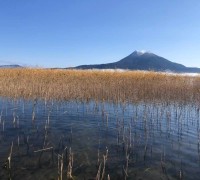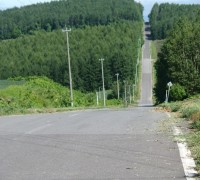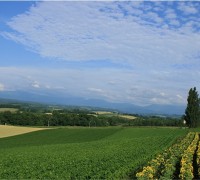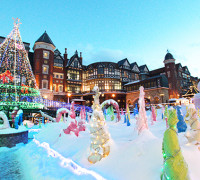An hour’s drive south from the center of Sapporo, beside a vineyard, is the
Hakkenzan Gallery, one of the centers of contemporary Ainu art. The Ainu people, an indigenous people of Japan, have long been highly regarded for their techniques and artistry in traditional Ainu wood carving and embroidery.
How do these traditions live on in contemporary Ainu art?

At the Hakkenzan Gallery, prints by
Koji Yuki, an Ainu printmaker,
musician, and poet, are on display
along with works by a local potter.
Today, a mini-concert will be held at
the gallery by “Polo”, a group that
performs creative story-telling
combined with Ainu folk music with an instrument called the “tonkori” and a Finnish folk instrument called the “kantele”.

The mountain that looks like eight swords attached to each other is Mt.
Hakkenzan, and the Hakkenzan Gallery is located in the grounds of the Hakkenzan Winery at the foot of the mountain. From the gallery, you can enjoy a 360-degree view of nature as well as Mt.Hakkenzan.

Many of Mr. Yuki’s prints feature
bears, which he says are kamui, or
deities, to the Ainu people. In 2001,
Mr. Yuki formed a group called the
“Ainu Art Project”, which has been
active in music, and in 2011, he was
invited by Le Clézio, the Nobel Prize
winning novelist, to perform story-
telling with the members of the group at an event held at the Louvre Museum.
In today’s concert, there were solo
and ensemble performances of “tonkori” and “kantele”, and Mr. Yuki talked about his own creative “yukar” or Ainu oral story, with the ensemble in the background. The story was about a bear cub being raised by a human mother.

Next to the Hakkenzan Gallery, there is
a restaurant and a store where you can
enjoy dishes made with local ingredien-
ts and buy wine. There is also a walking
path through vineyards and biotopes on
the premises, where you can enjoy
contemporary art in the midst of nature.
Mr. Yuki had the following to say about the Ainu tradition. The Ainu call
nature “kamui” or deities and have the sense that they are always surrounded by deities, and this sense is what is wonderful and what he wants to preserve as tradition.

The title of this print is “KEHAI
(sign)”, and it looks like various animals are lurking around. I would like to walk through the nature of Hokkaido depicted
in this work with my own feet and feel something. I also imagined myself in the future as a guide, telling people about it. “Don’t just dream about it, come to the forest!” I felt as if I could hear a voice from this work saying these words.
By Hiroko Moriwaka
RELATED ARTICLES
-
The Odori Park in Sapporo
-
Double-flowered cherry tree are beautifully blooming.
-
The spectacular night view of Sapporo
-
Marimo at Lake Akan
-
What is a trip for kids?
-
Beautiful Japanese Crane Tancho in Kushiro, Eastern Hokkaido
-
Ecorin Village in Eniwa: A Town of Flowers and Ecology
-
Pleasurable Farming Tours in Hokkaido
-
The present-day Ainu and Iomante -from the story of th...
-
The First Autumn Colours in Japan

















